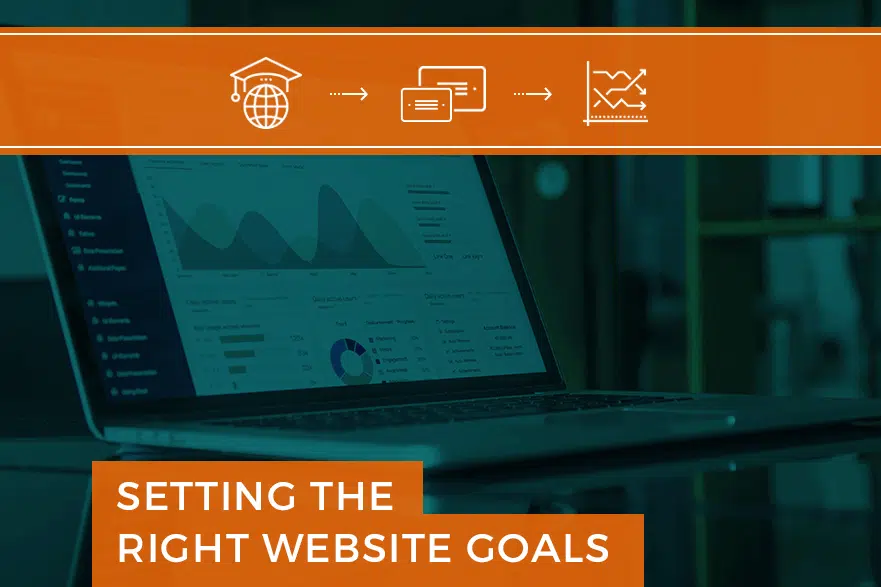

(This article is the second part of our 10-week series on inbound marketing. See part 1 here.)
Simply put, a website goal is an objective that you assign to your website. Many website goals tend to be something simple, like “obtain more website visits” or “sell more products”.
These examples of website goals are ones we hear all the time, and honestly, they’re terrible.
If you plan to get the best possible results from your website, you need to go beyond simple or arbitrary goals—or, inexcusably, an absence of goals.
Here are the best ways to set goals for your website:
 #1 – Using SMART Goals
#1 – Using SMART Goals
Setting goals isn’t easy, but fortunately, using the SMART goal system to set your goals will help guide you toward proper milestones, deadlines, and even help you build a roadmap to accomplish your goals.
SMART goals have 5 main attributes:
- Specific—who or what is involved in accomplishing this goal?
- Measurable—is there a way to gauge if the goal was accomplished?
- Attainable—is this a realistic goal to set, based on previous data?
- Relevant—will accomplishing this goal actually help your business?
- Time-bound—does this goal have a deadline?
Here are some SMART goal examples:
a) Based on our record of 100 website visits per month, our goal is to earn 200 website visits per month, a 100% increase, by October 31, 2016.
b) Since we currently sell 10 products per week on our website, our goal is to sell 15 products per week, a 50% increase, by January 1, 2017.
After setting these goals, you will need to create a plan to make these goals happen. (And, in case you haven’t been warned, the business/marketing plan is the hard part.)
Why do these matter?
Because SMART goals help prevent guaranteed goal failure.
For example, let’s say your original goal was to sell more items. Well, if you sell an average of 10,000 items per year, and you sell two more items this year, were you successful? Technically, yes—you sold more items. But really, does that make your efforts worthwhile? Not really, on that scale—it’s less than a 1% improvement.
And while you’re figuring out your goals, you should know the difference between these next two items:
 #2 – Knowing Your Micro-conversions and Macro-conversions
#2 – Knowing Your Micro-conversions and Macro-conversions
Micro-conversions are smaller conversions that help your communications, marketing, or sales goals along, but they don’t contribute to your bottom line. Micro-conversions are actions like website clicks, email sign-ups, or content downloads.
Macro-conversions are large conversions that impact your business’s bottom line. Macro-conversions include e-commerce order completions, subscription sign-ups, and other lead conversions.
Why do these matter?
Because you’ll need to set goals for both types of conversions. You’ll obviously want more sales and lead conversions overall, but let’s say you don’t have an e-commerce website.
Your main website goal might be to earn leads. After you earn website leads, you should be able to calculate how much revenue your website has on your business.
SEE ALSO: DOES YOUR WEBSITE HAVE A JOB TO DO?
 #3 – Understanding The Overall Business Impact
#3 – Understanding The Overall Business Impact
Lastly, many business owners forget to set the right website goals for their business. If you know that your business is mostly e-commerce, set sales goals for your website. If you’re an association, then sign-up goals will matter.
But the key is to make sure your website goals make sense for your overall business plan. If you have a store that sells 3 items per week, and you want to set up an e-commerce website to sell 20 items per week, you’ll need to reconsider your goal.
This is even more important if you have no data to back up these more ambitious goals. And, most importantly, you’ll need a marketing plan to do it.
Why does this matter?
Because it helps you set the right type of website goals for your business. Make no mistake: We see poorly chosen web-based goals for all types of businesses. Remember to set SMART goals, compare them to your overall business goals, and find the reasonable middle ground.
Just remember to take your entire business plan into consideration, and you’ll have a better chance at success.
Recent Articles
Write For Us
Think you’ve got a fresh perspective that will challenge our readers to become better marketers? We’re always looking for authors who can deliver quality articles and blog posts. Hundreds of your peers will read your work, and you will level up in the process.Ready to grow? Say Hello








